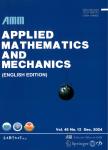Buoyant Marangoni convection of nanofluids in square cavity
Buoyant Marangoni convection of nanofluids in square cavity作者机构:School of Mathematical SciencesUniversiti Kebangsaan Malaysia Solar Energy Research InstituteUniversiti Kebangsaan Malaysia Research InstituteCenter for Modeling & Computer Simulation(RI/CM&CS)King Fahd University of Petroleum & Minerals
出 版 物:《Applied Mathematics and Mechanics(English Edition)》 (应用数学和力学(英文版))
年 卷 期:2015年第36卷第9期
页 面:1169-1184页
核心收录:
学科分类:080704[工学-流体机械及工程] 080103[工学-流体力学] 08[工学] 0807[工学-动力工程及工程热物理] 0801[工学-力学(可授工学、理学学位)]
基 金:Project supported by the Fundamental Research Grant Scheme of the Ministry of Education of Malaysia(No.FRGS/1/2014/SG04/UKM/01/1) the Dana Impak Perdana of Universiti Kebangsaan Malaysia(No.DIP-2014-015)
主 题:finite difference method Marangoni convection nanofluid
摘 要:The buoyant Marangoni convection heat transfer in a differentially heated cavity is numerically studied. The cavity is filled with water-Ag, water-Cu, water-Al2O3, and water-TiO2 nanofiuids. The governing equations are based on the equations involving the stream function, vorticity, and temperature. The dimensionless forms of the governing equations are solved by the finite difference (FD) scheme consisting of the alternating direction implicit (ADI) method and the tri-diagonal matrix algorithm (TDMA). It is found that the increase in the nanoparticle concentration leads to the decrease in the flow rates in the secondary cells when the convective thermocapillary and the buoyancy force have similar strength. A critical Marangoni number exists, below which increasing the Marangoni number decreases the average Nusselt number, and above which increasing the Marangoni number increases the average Nusselt number. The nanoparticles play a crucial role in the critical Marangoni number.




